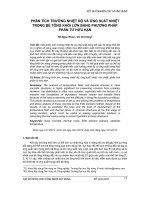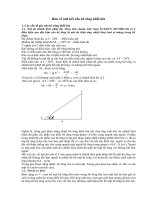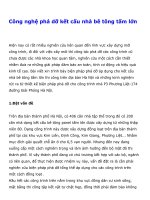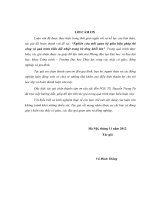Do be tong khoi lon
Bạn đang xem bản rút gọn của tài liệu. Xem và tải ngay bản đầy đủ của tài liệu tại đây (13.11 KB, 2 trang )
EM 1110-2-2200
30 Jun 95
Chapter 6
Temperature Control of Mass Concrete
6-1. Introduction
Temperature control of mass concrete is necessary to
prevent cracking caused by excessive tensile strains that
result from differential cooling of the concrete. The con-
crete is heated by reaction of cement with water and can
gain additional heat from exposure to the ambient con-
ditions. Cracking can be controlled by methods that limit
the peak temperature to a safe level, so the tensile strains
developed as the concrete cools to equilibrium are less
than the tensile strain capacity.
6-2. Thermal Properties of Concrete
a. General. The properties of concrete used in ther-
mal studies for the design of gravity dams are thermal
diffusivity, thermal conductivity, specific heat, coefficient
of thermal expansion, heat of hydration of the cement,
tensile strain capacity, and modulus of elasticity. The
most significant factor affecting the thermal properties is
the composition of the aggregates. The selection of suit-
able aggregates is based on other considerations, so little
or no control can be exercised over the thermal properties
of the aggregates. Type II cement with optional low heat
of hydration limitation and a cement replacement are
normally specified. Type IV low-heat cement has not
been used in recent years, because in most cases heat
development can be controlled by other measures and
type IV cement is not generally available.
b. Thermal conductivity. The thermal conductivity of
a material is the rate at which it transmits heat and is
defined as the ratio of the flux of heat to the temperature
gradient. Water content, density, and temperature signifi-
cantly influence the thermal conductivity of a specific
concrete. Typical values are 2.3, 1.7, and 1.2 British
thermal units (Btu)/hour/foot/Fahrenheit degree (°F) for
concrete with quartzite, limestone, and basalt aggregates,
respectively.
c. Thermal diffusivity. Diffusivity is described as an
index of the ease or difficulty with which concrete under-
goes temperature change and, numerically, is the thermal
conductivity divided by the product of specific heat and
density. Typical diffusivity values for concrete range
from 0.03 square foot/hour for basalt concrete to
0.06 square foot/hour for quartzite concrete.
d. Specific heat. Specific heat or heat capacity is the
heat required to raise a unit weight of material 1 degree.
Values for various types of concrete are about the same
and vary from 0.22 to 0.25 Btu’s/pound/°F.
e. Coefficient of thermal expansion. The coefficient
of thermal expansion can be defined as the change in
linear dimension per unit length divided by the tempera-
ture change expressed in millionths per °F. Basalt and
limestone concretes have values from 3 to 5 millionths/°F;
quartzite concretes range up to 8 millionths/°F.
f. Heat of hydration. The reaction of water with
cement is exothermic and generates a considerable amount
of heat over an extended period of time. Heats of hydra-
tion for various cements vary from 60 to 95 calories/gram
at 7 days and 70 to 110 calories/gram at 28 days.
g. Tensile strain capacity. Design is based on maxi-
mum tensile strain. The modulus of rupture test
(CRD-C 16) is done on concrete beams tested to failure
under third-point loading. Tensile strain capacity is deter-
mined by dividing the modulus of rupture by the modulus
of elasticity. Typical values range from 50 to
200 millions depending on loading rate and type of
concrete.
h. Creep. Creep of concrete is deformation that
occurs while concrete is under sustained stress. Specific
creep is creep under unit stress. Specific creep of mass
concrete is in the range of 1.4 × 10
-6
/pounds per square
inch (psi).
i. Modulus of elasticity. The instantaneous loading
modulus of elasticity for mass concrete ranges from about
1.5to6×10
6
psi and under sustained loading from about
0.5to4×10
6
psi.
6-3. Thermal Studies
a. General. During the design of gravity dams, it is
necessary to assess the possibility that strain induced by
temperature changes in the concrete will not exceed the
strain capacity of the concrete. Detailed design proce-
dures for control of the generation of heat and volume
changes to minimize cracking may be found in the ACI
Manual of Concrete Practice, Section 207. The following
concrete parameters should be determined by a division
laboratory: heat of hydration (CRD-C 229), adiabatic
temperature rise (CRD-C 38), thermal conductivity
(CRD-C 44), thermal diffusivity (CRD-C 37), specific
6-1
EM 1110-2-2200
30 Jun 95
heat (CRD-C 124), coefficient of thermal expansion
(CRD-C 397, 125, and 126), creep (CRD-C 54), and
tensile strain capacity (CRD-C 71). Thermal properties
testing should not be initiated until aggregate
investigations have proceeded to the point that the most
likely aggregate sources are determined and the availabil-
ity of cementitious material is known.
b. Allowable peak temperature. The peak tempera-
ture for the interior mass concrete must be controlled to
prevent cracking induced by surface contraction. The
allowable peak temperature commonly used to prevent
serious cracking in mass concrete structures is the mean
annual ambient temperature plus the number of degrees
Fahrenheit determined by dividing the tensile strain capac-
ity by the coefficient of linear expansion. This assumes
that the concrete will be subjected to 100-percent restraint
against contraction. When the potential temperature rise
of mass concrete is reduced to this level, the temperature
drop that causes tensile strain and cracking is reduced to
an acceptable level.
6-4. Temperature Control Methods
The temperature control methods available for consider-
ation all have the basic objective of reducing increases in
temperature due to heat of hydration, reducing thermal
differentials within the structure, and reducing exposure to
cold air at the concrete surfaces that would create
cracking. The most common techniques are the control of
lift thickness, time interval between lifts, maximum allow-
able placing temperature of the concrete, and surface
insulation. Postcooling may be economical for large
structures. Analysis should be made to determine the
most economic method to restrict temperature increases
and subsequent temperature drops to levels just safely
below values that could cause undesirable cracking. For
structures of limited complexity, such as conventionally
shaped gravity dams, satisfactory results may be obtained
by use of the design procedures in ACI 207 “Mass Con-
crete for Dams and Other Massive Structures.” Roller
compacted concrete thermal control options include the
installation of contraction joints, winter construction,
mixture design, and increased heat dissipation. Contrac-
tion joints can be created by inserting a series of cuts or
metal plates into each lift to produce a continuous vertical
joint. Using very high production and placement rates,
RCC construction can be limited to colder winter months
without excessive schedule delays. The normal lift height
of 1 to 2 feet provides for an increased rate of heat dissi-
pation during cool weather.
6-2









